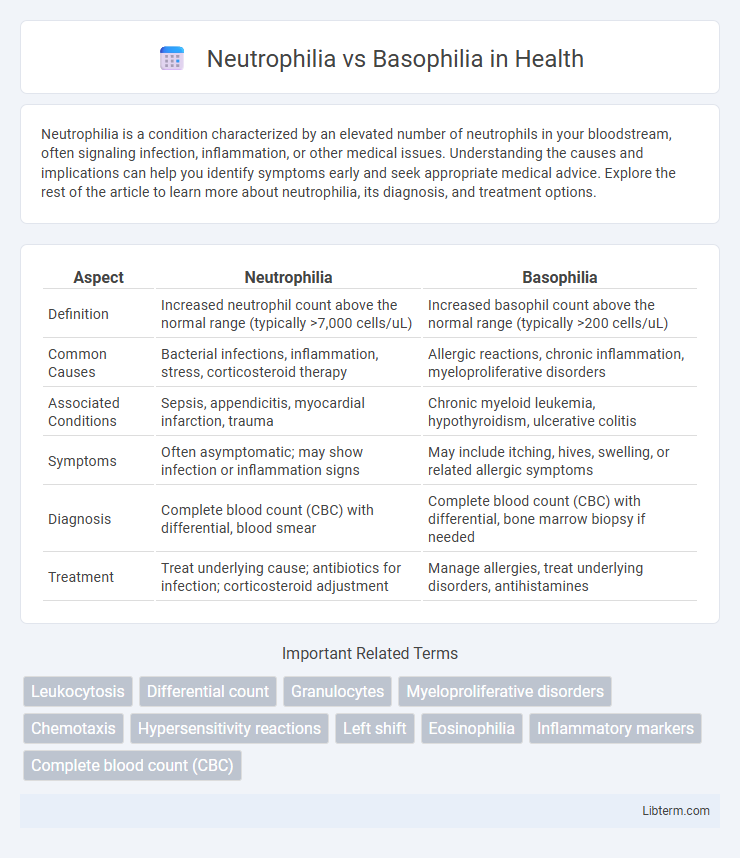Neutrophilia is a condition characterized by an elevated number of neutrophils in your bloodstream, often signaling infection, inflammation, or other medical issues. Understanding the causes and implications can help you identify symptoms early and seek appropriate medical advice. Explore the rest of the article to learn more about neutrophilia, its diagnosis, and treatment options.
Table of Comparison
| Aspect | Neutrophilia | Basophilia |
|---|---|---|
| Definition | Increased neutrophil count above the normal range (typically >7,000 cells/uL) | Increased basophil count above the normal range (typically >200 cells/uL) |
| Common Causes | Bacterial infections, inflammation, stress, corticosteroid therapy | Allergic reactions, chronic inflammation, myeloproliferative disorders |
| Associated Conditions | Sepsis, appendicitis, myocardial infarction, trauma | Chronic myeloid leukemia, hypothyroidism, ulcerative colitis |
| Symptoms | Often asymptomatic; may show infection or inflammation signs | May include itching, hives, swelling, or related allergic symptoms |
| Diagnosis | Complete blood count (CBC) with differential, blood smear | Complete blood count (CBC) with differential, bone marrow biopsy if needed |
| Treatment | Treat underlying cause; antibiotics for infection; corticosteroid adjustment | Manage allergies, treat underlying disorders, antihistamines |
Introduction to Neutrophilia and Basophilia
Neutrophilia is a hematologic condition characterized by an elevated neutrophil count in the blood, often indicating acute bacterial infection, inflammation, or stress response. Basophilia refers to an increased basophil count, commonly associated with allergic reactions, chronic inflammation, or myeloproliferative disorders such as chronic myeloid leukemia. Both conditions are detected through complete blood count (CBC) tests and serve as important diagnostic markers in clinical hematology.
Definition of Neutrophilia
Neutrophilia is defined as an increased number of neutrophils in the bloodstream, often exceeding 7,000 cells per microliter in adults, and it typically indicates an acute inflammatory response or infection. Unlike basophilia, which is characterized by an elevated basophil count often associated with allergic reactions or chronic myeloproliferative disorders, neutrophilia primarily signals bacterial infections, tissue injury, or stress. Understanding the distinct pathophysiological roles of neutrophils and basophils is crucial for accurate diagnosis and targeted treatment.
Definition of Basophilia
Basophilia is characterized by an elevated number of basophils in the blood, typically exceeding 0.1 x 10^9/L, and is often associated with allergic reactions, chronic inflammation, or myeloproliferative disorders. Neutrophilia, in contrast, refers to an increased neutrophil count, usually indicative of bacterial infections or acute inflammation. Understanding basophilia's definition and causes helps differentiate it from neutrophilia, guiding accurate diagnosis and treatment.
Causes of Neutrophilia
Neutrophilia is primarily caused by bacterial infections, inflammation, stress, and certain medications such as corticosteroids, while basophilia is often associated with allergic reactions, chronic inflammation, and myeloproliferative disorders. Conditions like acute bacterial infections stimulate the bone marrow to produce excess neutrophils, resulting in neutrophilia. In contrast, basophilia arises from increased basophil production due to hypersensitivity reactions or bone marrow diseases such as chronic myeloid leukemia.
Causes of Basophilia
Basophilia is primarily caused by allergic reactions, chronic inflammation, and certain myeloproliferative disorders such as chronic myeloid leukemia. In contrast, neutrophilia typically results from bacterial infections, acute inflammation, and stress responses. Elevated basophil levels often indicate hypersensitivity conditions or hematologic diseases, making differential diagnosis essential for targeted treatment.
Clinical Manifestations and Symptoms
Neutrophilia commonly presents with symptoms of infection or inflammation such as fever, localized pain, and redness due to an increased neutrophil count in response to bacterial infections or tissue damage. Basophilia is often associated with allergic reactions, chronic myeloproliferative disorders, or hypothyroidism and manifests through symptoms like itching, hives, or unexplained bruising caused by elevated basophil levels releasing histamine and other mediators. Both conditions may exhibit non-specific systemic symptoms like fatigue and malaise but differ significantly in their underlying causes and clinical features.
Diagnostic Criteria and Laboratory Findings
Neutrophilia is characterized by an absolute neutrophil count exceeding 7,000 cells/mL, often observed in bacterial infections, inflammation, or myeloproliferative disorders, with a peripheral blood smear showing mature and band neutrophils. Basophilia is defined by basophil counts above 200 cells/mL and is commonly associated with chronic myeloid leukemia, hypersensitivity reactions, or thyroid disorders, often confirmed by elevated serum histamine and increased basophil granules on blood smears. Laboratory findings for neutrophilia include elevated white blood cell counts with a left shift, while basophilia diagnosis relies on differential counts and bone marrow biopsy for clonal or reactive hyperplasia.
Differences Between Neutrophilia and Basophilia
Neutrophilia is characterized by an elevated number of neutrophils, typically indicating bacterial infections, inflammation, or physical stress, whereas basophilia involves an increased basophil count, often linked to allergic reactions, chronic inflammation, or myeloproliferative disorders. Neutrophils play a critical role in phagocytosis and rapid response to pathogens, while basophils contribute to hypersensitivity responses through the release of histamine and other mediators. Laboratory blood tests differentiate these conditions by quantifying specific white blood cell types, guiding diagnosis and treatment strategies based on underlying causes.
Management and Treatment Options
Management of neutrophilia primarily targets the underlying cause, such as infections, inflammation, or myeloproliferative disorders, often involving antibiotics, anti-inflammatory drugs, or cytoreductive therapy. Basophilia treatment focuses on addressing conditions like chronic myeloid leukemia or allergic reactions, utilizing targeted therapies such as tyrosine kinase inhibitors or antihistamines. Both conditions require regular monitoring of blood counts and symptom management to prevent complications and guide therapeutic adjustments.
Conclusion and Prognosis
Neutrophilia often indicates acute bacterial infections or inflammation and generally resolves with effective treatment, showing a favorable prognosis. Basophilia is rarer and typically associated with chronic myeloproliferative disorders or allergic reactions, which may require long-term management and can signify a more complex prognosis. Both conditions necessitate targeted diagnostic evaluation to determine underlying causes and appropriate therapeutic strategies.
Neutrophilia Infographic

 libterm.com
libterm.com